The best martial art for self-defense is going to be important when law and order break down. Choosing the forms and disciplines that work for you is crucial and a big commitment, so choose wisely.
In a worst-case scenario, there will be numerous situations where you are forced to defend yourself, your loved ones, and your property.
Being able to defend yourself could often mean the difference between life and death
As weeks and months go by, people will no longer have access to traditional weapons such as guns and ammunition. The ability to defend yourself will be crucial to your survival!
Table of contents
- The Best Martial Art for Self-Defense – Physical Benefits
- The Best Martial Art for Self-Defense – Mental Benefits
- Choosing Your Martial Art Discpline
- The Best Martial Art for Self-Defense – Disciplines
- Arnis
- Bojutsu
- Boxing
- Judo
- Kickboxing
- The Best Martial Art for Self-Defense – Conclusion
- Practice Weapons
- Related Articles
The Best Martial Art for Self-Defense – Physical Benefits
People have been developing ways to defend themselves for centuries. Different types of martial arts have evolved, with varying philosophies and techniques.
All types of martial arts offer benefits crucial in any life-or-death situation. While some martial arts may favor offense over defense, the ability to avoid injury and resist attacks is generally part of any martial art discipline.
Physical fitness is one of the benefits of martial arts training and results in a stronger and faster body. Physical fitness is going to be a considerable advantage in a self-defense situation. Being able to fight is important, but if the odds are not in your favor, you need to be able to break free and get away fast! Good endurance will ensure you get away and stay away, living to take care of those things important to you.
Martial Arts Training – Additional Physical Benefits
Martial arts create physical and mental toughness. Ideally, you’ll avoid hard blows, but in those instances where you are not, your body will be tough enough to absorb the shock of a blow or kick.
Increased strength from well-developed muscles will allow you to hit your attackers with more force. In addition, faster reflexes and improved balance will give you the ability to land punches and kicks more accurately and with greater frequency.
If you are not interested in learning a new discipline, you can also check out these self-defense techniques.
The Best Martial Art for Self-Defense – Mental Benefits
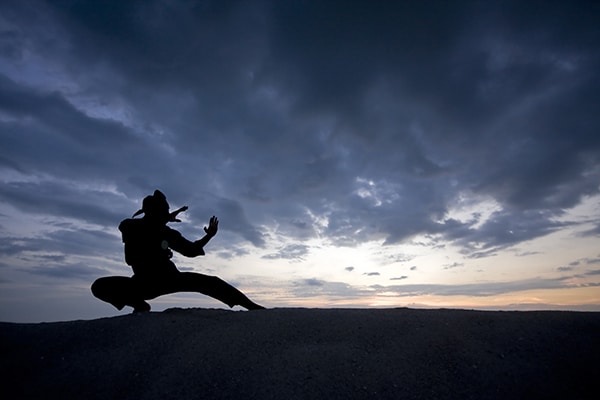
There are numerous mental benefits associated with martial arts training. These will not only aid you in life-or-death situations, but they will also enhance your everyday quality of life.
- Discipline
- Self-confidence
- Inflicting harm or injury
- No hesitation
Discipline
Discipline in anything requires constant training. “Practice makes perfect” is a fact! Performing the same moves and techniques over and over until they become second nature takes discipline.
Don’t underestimate the importance of discipline in everything you do. When situations are tough, the discipline you fall back on will take over and make you successful.
Self-confidence
Self-confidence in well-trained fighters is obvious in their style, mannerisms, and actions. Predators can spot a self-confident opponent and will often back away before starting a fight.
The way you walk, talk, and react tells those up to no good or looking for a confrontation that you will be a tough fight. Your self-confidence is a loud signal telling predators to back off!
Inflicting Harm or Injury
Hurting another person does not come naturally. Whether you are fighting or using weapons, the ability to harm an opponent when it is most needed is an action that requires training.
Training will provide the techniques needed to inflict harm with the most effective methods. In addition, repetitive training makes these skills easier and teaches you when they are needed and how to utilize them.
Choosing Your Martial Art Discpline
Choosing the martial art discipline that is right for you should not be taken lightly. There are different styles, with some more focused on defensive styles and others on the offensive. Before making a decision, there are several steps to take.
- Read about the disciplines you are interested in researching, and narrow down the list.
- Make a list of Dojos and studios in your area. Talk to the teachers and watch classes.
- Price is important, so find these out upfront, your comfort with a style is most important.
- Talk to other students about the pros and cons of a particular style.
Below is a good list of books on martial art philosophies and disciplines.
- The Art of War
- The Book of Five Rings
- Bruce Lee Jeet Kune Do: A Comprehensive Guide to Bruce Lee’s Martial Way
- Kodokan Judo: The Essential Guide to Judo by it’s founder Jigoro Kano
- A Woman’s Guide to Martial Arts: How to Choose a Discipline and Get Started
The Best Martial Art for Self-Defense – Disciplines
Martial arts provide many disciplines. Finding the one that works best for you requires several decisions. When making these decisions, remember to consider your situation.
If you are in a life-or-death situation, you will want every possible tool at your disposal. This means learning how to use weapons. Unfortunately, there is a good chance that you will only have hand-to-hand combat weapons in a worst-case scenario.
Arnis
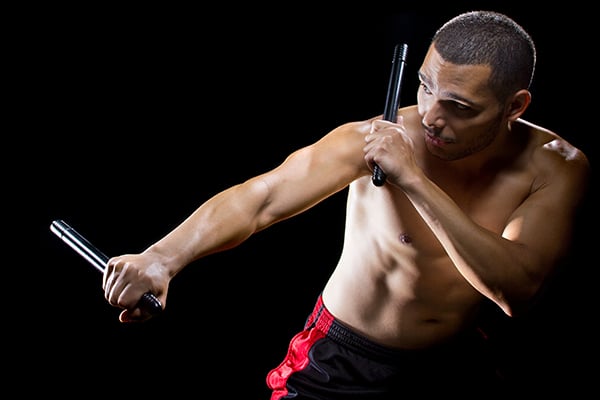
A good martial art discipline for self-defense is Arnis. This martial art teaches the use of stick weapons. The sticks used are generally made of wood and are approximately 26 inches long. Arnis teaches with one or two sticks.
This martial art focuses on the flow of the various techniques to make movements smooth and strikes sharp. In addition, students will learn how to dodge an attacker’s weapons and disable or disarm an attacker using the sticks.
Arnis is beneficial in a survival situation because of the type of weapon. Lightweight sticks should be easy to find in a survival situation. The Sticks can be kept at home or work, and it is easy to carry the sticks in a bag or weapon case. In addition, sticks are easy to keep on hand, so you are not caught in a situation with no weapons.
If you only want to disarm or incapacitate an attacker, then Arnis is a discipline to consider. However, if Arnis training is not found in your area, you can also consider Bojutsu, which uses a long stick or staff.
Bojutsu
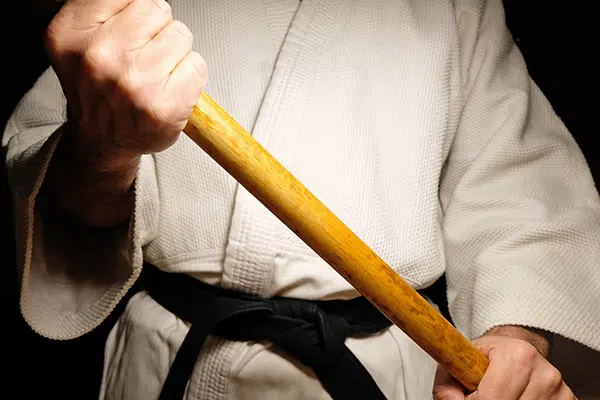
Bojutsu is a martial art discipline that uses a staff, providing increased reach over other weapons. Whether the staff is used to strike, slash or stab, you’re more likely to damage your attacker without injury to yourself because of the distance your weapon can cover.
There are pros and cons to a staff, with two of the biggest benefits being the weapon’s length and how easily wooden sticks can be found. There are some disadvantages to using a staff though.
One downside is the loss of control for self-defense purposes. The staff’s increased reach and length are good for the first few strikes and going on the offensive. However, once an attacker has been able to close the distance, the staff’s increased length can make it more difficult to evade attacks or otherwise defend with the same maneuverability of the Arnis sticks.
Portability is another disadvantage of a staff. It’s unwieldy and difficult to bring a staff wherever you go.
Boxing
If you are trying to decide which martial art is right for you, one good place to start is with boxing training. Boxing offers multiple techniques that can be used in other disciplines.
- A correct defensive stance that provides multiple layers of protection to protect your torso and face.
- Proper footwork and balance to avoid and line of attack and incoming blows.
- How to adjust your body’s angles to deflect blows.
Boxing allows your body to become tough through constant physical training. Your reflexes and ability to anticipate blows will be improved through constant sparring with other fighters. There is no better training than actual fighting.
While boxing is a good beginning, it is not a full-body discipline. Boxers do not learn how to use the other parts of their body, such as elbows, knees, and feet, to slow down or keep an attacker at bay. Learning how to defend against an attacker that has pulled you to the ground is also important, and this training is not provided by boxing.
Turning to martial arts will cover the disciplines that boxing does not.
Judo
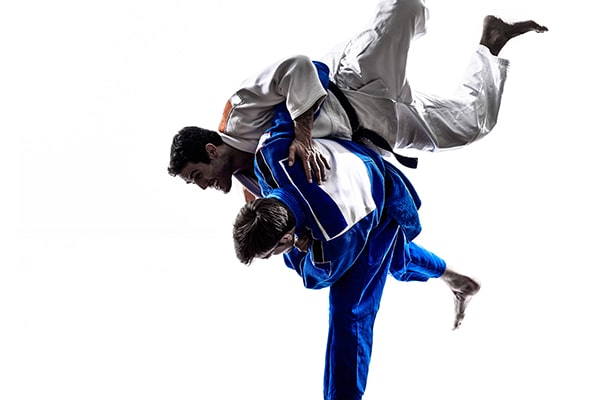
Judo is considered one of the best martial arts for self-defense on the ground or when you need to defend against a larger attacker. Defense in these scenarios involves pulling, pushing, grappling, and pinning than the elegant strikes and flying kicks of other martial art disciplines.
Learning judo will provide techniques for getting out of situations where an attacker has a victim pinned to the ground or is attempting to choke them to death.
Judo also teaches students how to use position and momentum to their advantage, making it easy for smaller defenders to handle a large attacker. A small defender can use larger attackers’ flow and momentum to throw them to the ground with timing and technique.
Focusing on more fragile and vulnerable body parts is also important in Judo.
Predators will go after what they perceive as weaker prey. If a smaller opponent knows Judo, the attacker is probably in for a surprise.
People will tend to go after those they feel are weaker or smaller than them in a survival situation. If you have gained proficiency in judo, you will have less to fear even if you are smaller than or not as muscular as your attacker.
Kickboxing
Kickboxing is lighter on defensive techniques than other martial arts, but it does offer several benefits. If you are forced into unarmed combat, the disadvantage of attacking with fists is that your reach will be limited.
This is a problem if your attacker is armed with a weapon that has a more extended reach, like a pole, chain, piece of wood, or cleaver. In these instances, being able to attack with your feet and legs is an advantage. Your ability to use your feet and legs effectively will keep attackers with weapons at bay.
The Best Martial Art for Self-Defense – Conclusion
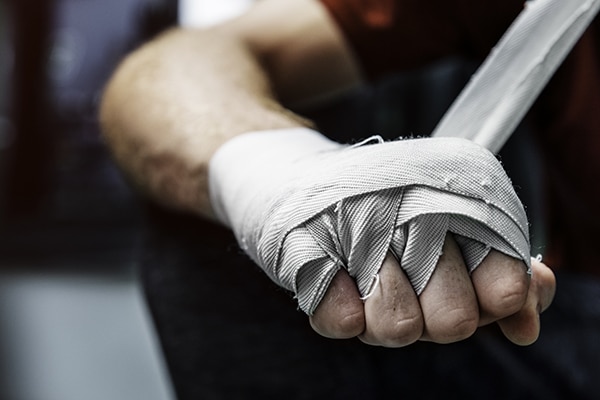
Remember that there is no correct answer when choosing the best martial art for you. First, you must find a martial art that you are passionate about learning and can commit to long-term.
All martial arts training offers benefits – improving your physical fitness, increasing your mental discipline, making you tougher and more alert, and preparing you to handle life and death situations. In addition, the more knowledge you have, the higher your chances are for survival when disaster strikes.









I have been practicing Aikido for more than 15 years and I am sure that it is applicable to all self-defence situations. Especially, Aikido is good in the cases when your opponent is taller or heavier than you are. But it starts working after the years of training…
Of course, if you want to learn how to defend yourself in short terms you should choose between Boxing and Muay Thai. However, I prefer Aikido for it’s ergonomic and aestetic movements. Just begin to learn Aikido and you’ll be impressed how powerful and creative it is!
Thank you for sharing with us, Timmy!
Martial arts not only enhances your physical but it also nourishes your mind as most dojos would require their students or practitioners to practice meditation before or after class. These classes also help you focus and remain alert at all times.
Hi Sarah,
Meditation plays an important part in martial arts, something you will learn as you continue practicing.
You had forgot the ultimate best one from this list: Krav Maga. Not only it teaches self-defense in virtually any situation, with or without weapons (on you and/or on the attacker and temporary use of different objects as a weapon, etc.), it also teaches about the mental structures in stressful situations and teaches you to decode various, subconsicous gestures people do when under stressful situations and then teaches you to act accordingly. There is a reason why this method is used as a close-combat system by the majority of the armies in the world, too. It’s really, really effective when done right. No matter is it the military, public authority, or the civilian version of it, the techniques overlap in many occasions.
The Krav Maga is one of the best self-defense techniques. Personally, I find it to be very resourceful, since I do not necessarily need a weapon to incapacitate an attacker.